YAMAHA XT1200Z 2014 Workshop Manual
Manufacturer: YAMAHA, Model Year: 2014, Model line: XT1200Z, Model: YAMAHA XT1200Z 2014Pages: 116, PDF Size: 3.11 MB
Page 51 of 116
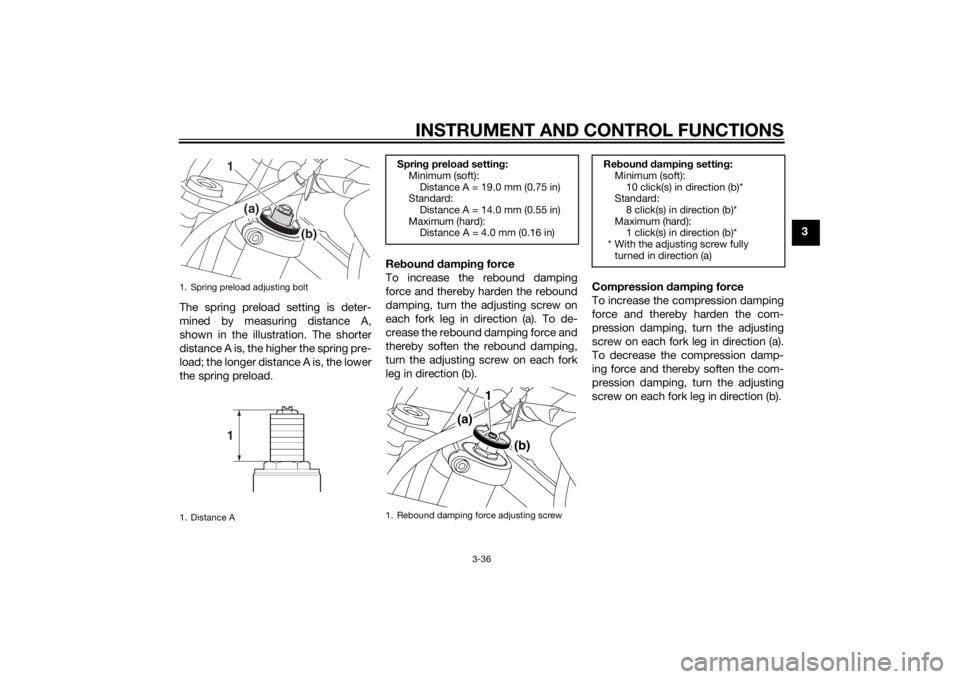
INSTRUMENT AND CONTROL FUNCTIONS
3-36
3
The spring preload setting is deter-
mined by measuring distance A,
shown in the illustration. The shorter
distance A is, the higher the spring pre-
load; the longer distance A is, the lower
the spring preload. Re
boun d d ampin g force
To increase the rebound damping
force and thereby harden the rebound
damping, turn the adjusting screw on
each fork leg in direction (a). To de-
crease the rebound damping force and
thereby soften the rebound damping,
turn the adjusting screw on each fork
leg in direction (b). Compression
dampin g force
To increase the compression damping
force and thereby harden the com-
pression damping, turn the adjusting
screw on each fork leg in direction (a).
To decrease the compression damp-
ing force and thereby soften the com-
pression damping, turn the adjusting
screw on each fork leg in direction (b).
1. Spring preload adjusting bolt
1. Distance A
1
(a) (b)1
Spring preloa d settin g:
Minimum (soft):
Distance A = 19.0 mm (0.75 in)
Standard:
Distance A = 14.0 mm (0.55 in)
Maximum (hard): Distance A = 4.0 mm (0.16 in)
1. Rebound damping force adjusting screw
1
(a)
(b)
Re boun d d ampin g settin g:
Minimum (soft):
10 click(s) in direction (b)*
Standard:
8 click(s) in direction (b)*
Maximum (hard): 1 click(s) in direction (b)*
* With the adjusting screw fully turned in direction (a)
U2BSE0E0.book Page 36 Tuesday, September 17, 2013 8:55 AM
Page 52 of 116
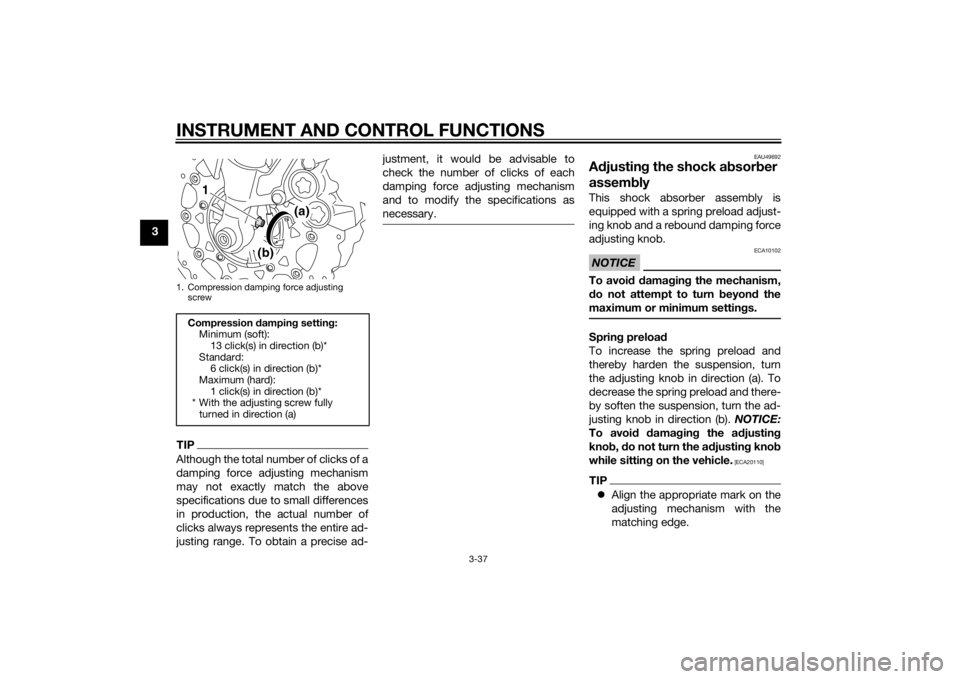
INSTRUMENT AND CONTROL FUNCTIONS
3-37
3
TIPAlthough the total number of clicks of a
damping force adjusting mechanism
may not exactly match the above
specifications due to small differences
in production, the actual number of
clicks always represents the entire ad-
justing range. To obtain a precise ad-justment, it would be advisable to
check the number of clicks of each
damping force adjusting mechanism
and to modify the specifications as
necessary.
EAU49692
A
djustin g the shock a bsorb er
assem blyThis shock absorber assembly is
equipped with a spring preload adjust-
ing knob and a rebound damping force
adjusting knob.NOTICE
ECA10102
To avoi d d amag ing the mechanism,
d o not attempt to turn b eyond the
maximum or minimum settin gs.Sprin g preloa d
To increase the spring preload and
thereby harden the suspension, turn
the adjusting knob in direction (a). To
decrease the spring preload and there-
by soften the suspension, turn the ad-
justing knob in direction (b). NOTICE:
To avoi d dama gin g the a djustin g
kno b, d o not turn the a djustin g kno b
while sittin g on the vehicle.
[ECA20110]
TIP Align the appropriate mark on the
adjusting mechanism with the
matching edge.
1. Compression damping force adjusting
screwCompression dampin g settin g:
Minimum (soft): 13 click(s) in direction (b)*
Standard: 6 click(s) in direction (b)*
Maximum (hard):
1 click(s) in direction (b)*
* With the adjusting screw fully turned in direction (a)
1
(a)
(b)
U2BSE0E0.book Page 37 Tuesday, September 17, 2013 8:55 AM
Page 53 of 116
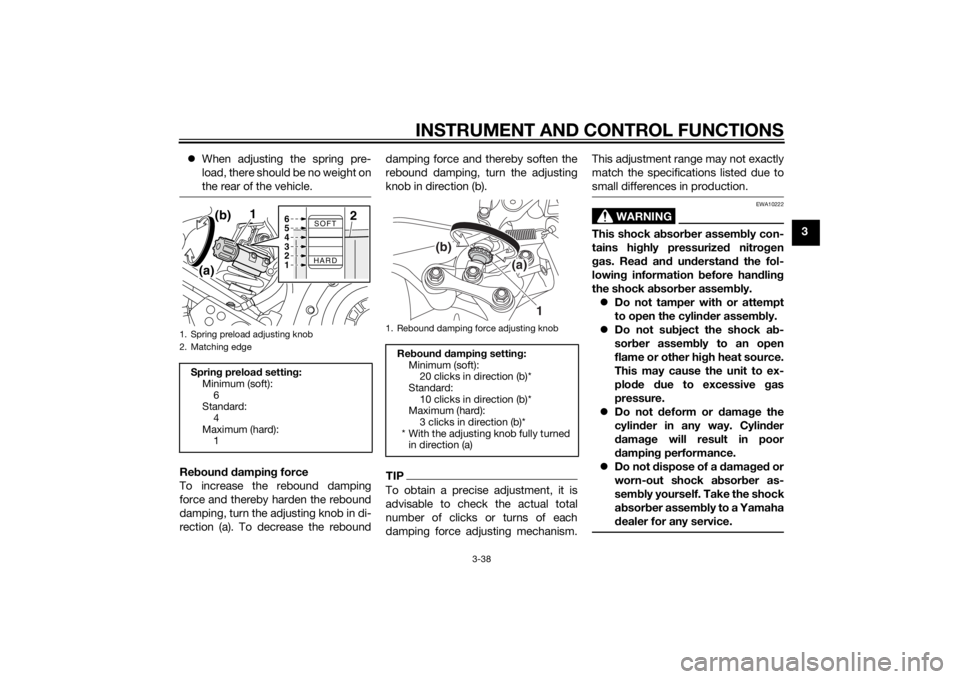
INSTRUMENT AND CONTROL FUNCTIONS
3-38
3
When adjusting the spring pre-
load, there should be no weight on
the rear of the vehicle.
Reboun d d ampin g force
To increase the rebound damping
force and thereby harden the rebound
damping, turn the adjusting knob in di-
rection (a). To decrease the rebound damping force and thereby soften the
rebound damping, turn the adjusting
knob in direction (b).
TIPTo obtain a precise adjustment, it is
advisable to check the actual total
number of clicks or turns of each
damping force adjusting mechanism. This adjustment range may not exactly
match the specifications listed due to
small differences in production.
WARNING
EWA10222
This shock a
bsor ber assem bly con-
tains hig hly pressurize d nitro gen
g as. Rea d an d un derstan d the fol-
lowin g information before han dlin g
the shock a bsor ber assem bly.
Do not tamper with or attempt
to open the cylind er assembly.
Do not su bject the shock a b-
sor ber assem bly to an open
flame or other hi gh heat source.
This may cause the unit to ex-
plo de due to excessive gas
pressure.
Do not deform or damag e the
cylin der in any way. Cylin der
d ama ge will result in poor
d ampin g performance.
Do not dispose of a damag ed or
worn-out shock a bsor ber as-
sem bly
yourself. Take the shock
a b sor ber assem bly to a Yamaha
d ealer for any service.
1. Spring preload adjusting knob
2. Matching edgeSprin g preloa d settin g:
Minimum (soft): 6
Standard:
4
Maximum (hard): 1
SOFT
HARD
1
(b)
(a)
6
5
4
3
2
1
2
1. Rebound damping force adjusting knob
Re boun d d ampin g settin g:
Minimum (soft): 20 clicks in direction (b)*
Standard: 10 clicks in direction (b)*
Maximum (hard):
3 clicks in direction (b)*
* With the adjusting knob fully turned in direction (a)
1
(b)
(a)
U2BSE0E0.book Page 38 Tuesday, September 17, 2013 8:55 AM
Page 54 of 116
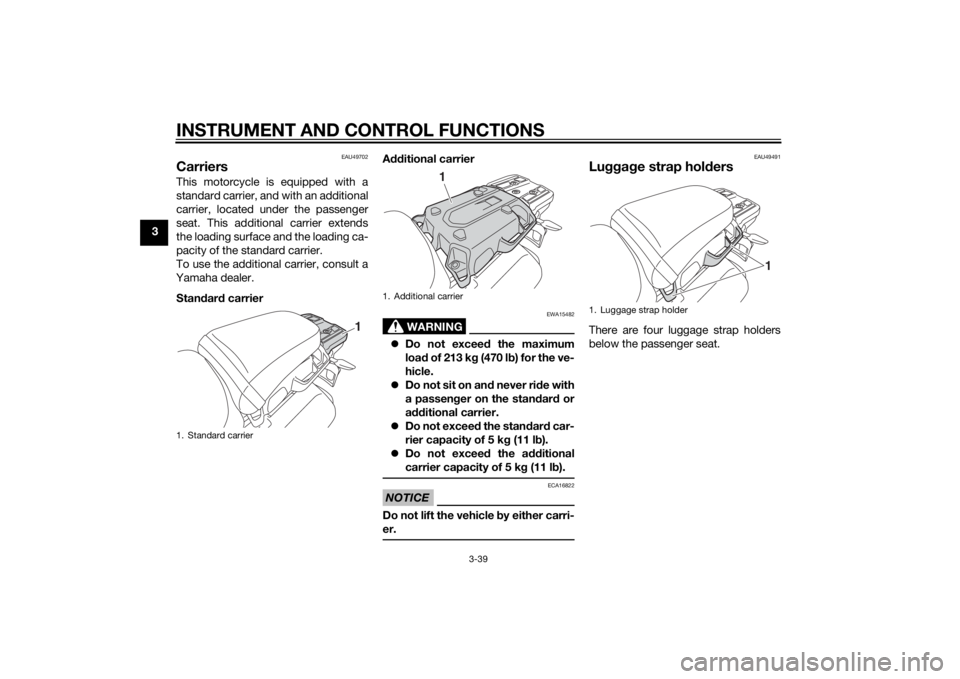
INSTRUMENT AND CONTROL FUNCTIONS
3-39
3
EAU49702
CarriersThis motorcycle is equipped with a
standard carrier, and with an additional
carrier, located under the passenger
seat. This additional carrier extends
the loading surface and the loading ca-
pacity of the standard carrier.
To use the additional carrier, consult a
Yamaha dealer.
Stan dar d carrier A
dditional carrier
WARNING
EWA15482
Do not exceed the maximum
loa d of 213 k g (470 l b) for the ve-
hicle.
Do not sit on an d never ri de with
a passen ger on the stan dar d or
a dditional carrier.
Do not exceed the standar d car-
rier capacity of 5 k g (11 l b).
Do not exceed the additional
carrier capacity of 5 kg (11 lb).NOTICE
ECA16822
Do not lift the vehicle by either carri-
er.
EAU49491
Lugga ge strap hol dersThere are four luggage strap holders
below the passenger seat.
1. Standard carrier
1
1. Additional carrier
1
1. Luggage strap holder
1
U2BSE0E0.book Page 39 Tuesday, September 17, 2013 8:55 AM
Page 55 of 116
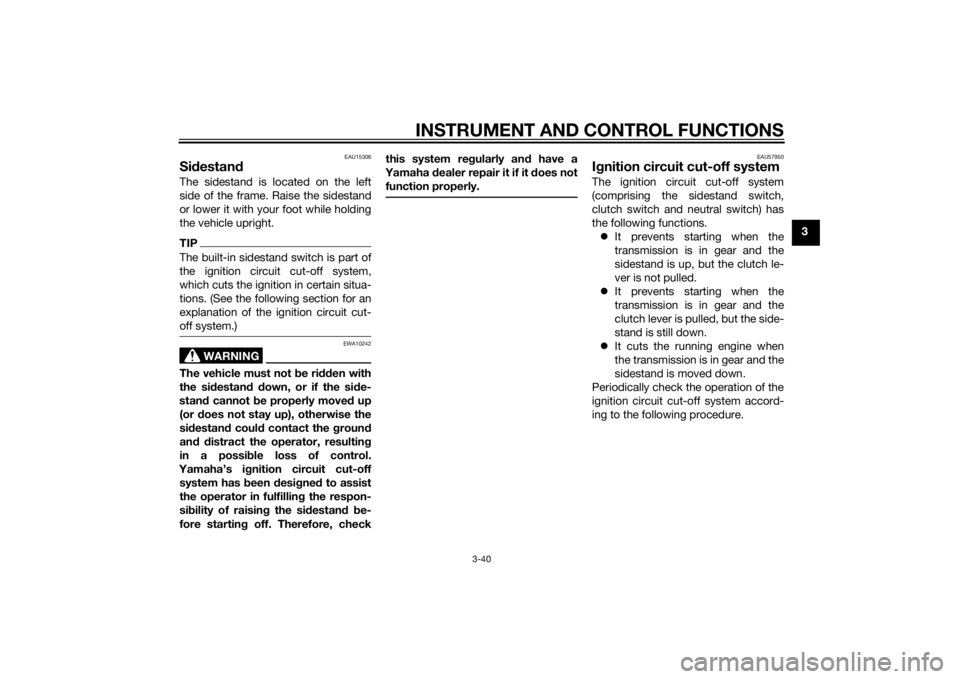
INSTRUMENT AND CONTROL FUNCTIONS
3-40
3
EAU15306
Sidestan dThe sidestand is located on the left
side of the frame. Raise the sidestand
or lower it with your foot while holding
the vehicle upright.TIPThe built-in sidestand switch is part of
the ignition circuit cut-off system,
which cuts the ignition in certain situa-
tions. (See the following section for an
explanation of the ignition circuit cut-
off system.)
WARNING
EWA10242
The vehicle must not b e ridden with
the si destan d d own, or if the si de-
stan d cannot b e properly move d up
(or does not stay up), otherwise the
si destan d coul d contact the groun d
an d d istract the operator, resultin g
in a possi ble loss of control.
Yamaha’s i gnition circuit cut-off
system has been desi gne d to assist
the operator in fulfilling the respon-
si bility of raisin g the si destan d b e-
fore startin g off. Therefore, check this system re
gularly an d have a
Yamaha dealer repair it if it does not
function properly.
EAU57950
I g nition circuit cut-off systemThe ignition circuit cut-off system
(comprising the sidestand switch,
clutch switch and neutral switch) has
the following functions.
It prevents starting when the
transmission is in gear and the
sidestand is up, but the clutch le-
ver is not pulled.
It prevents starting when the
transmission is in gear and the
clutch lever is pulled, but the side-
stand is still down.
It cuts the running engine when
the transmission is in gear and the
sidestand is moved down.
Periodically check the operation of the
ignition circuit cut-off system accord-
ing to the following procedure.
U2BSE0E0.book Page 40 Tuesday, September 17, 2013 8:55 AM
Page 56 of 116
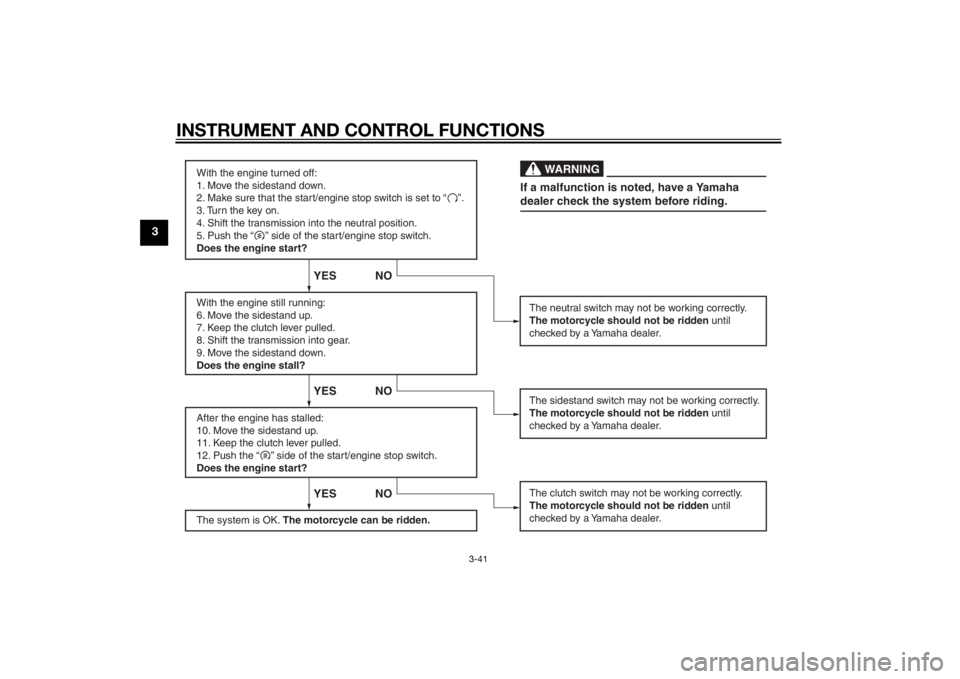
INSTRUMENT AND CONTROL FUNCTIONS
3-41
3
With the engine turned off:
1. Move the sidestand down.
2. Make sure that the start/engine stop switch is set to “ ”.
3. Turn the key on.
4. Shift the transmission into the neutral position.
5. Push the “ ” side of the start/engine stop switch.
Does the engine start?
With the engine still running:
6. Move the sidestand up.
7. Keep the clutch lever pulled.
8. Shift the transmission into gear.
9. Move the sidestand down.
Does the engine stall?
After the engine has stalled:
10. Move the sidestand up.
11. Keep the clutch lever pulled.
12. Push the “ ” side of the start/engine stop switch.
Does the engine start?
The system is OK. The motorcycle can be ridden.
YES NO YES NO YES NO
The neutral switch may not be working correctly.
The motorcycle should not be ridden until
checked by a Yamaha dealer.
The clutch switch may not be working correctly.
The motorcycle should not be ridden until
checked by a Yamaha dealer.The sidestand switch may not be working correctly.
The motorcycle should not be ridden until
checked by a Yamaha dealer.If a malfunction is noted, have a Yamaha
dealer check the system before riding.
WA R N I N G
U2BSE0E0.book Page 41 Tuesday, September 17, 2013 8:55 AM
Page 57 of 116

INSTRUMENT AND CONTROL FUNCTIONS
3-42
3
EAU49453
Auxiliary DC jack
WARNING
EWA14361
To prevent electrical shock or short-
circuiting, make sure that the cap is
installe d when the auxiliary DC jack
is not bein g use d.NOTICE
ECA15432
The accessory connected to the
auxiliary DC jack shoul d not b e used
with the en gine turne d off, an d the
loa d must never excee d 30 W (2.5 A),
otherwise the fuse may blow or the
b attery may dischar ge.This vehicle is equipped with an auxil-
iary DC jack.
A 12-V accessory connected to the
auxiliary DC jack can be used when the
key is in the “ON” position and should
only be used when the engine is run-
ning.
To use the auxiliary DC jack
1. Turn the key to “OFF”.
2. Remove the auxiliary DC jack cap. 3. Turn the accessory off.
4. Insert the accessory plug into the
auxiliary DC jack.
5. Turn the key to “ON”, and then start the engine. (See page 5-1.)
6. Turn the accessory on.
1. Auxiliary DC jack cap
1. Auxiliary DC jack
11
U2BSE0E0.book Page 42 Tuesday, September 17, 2013 8:55 AM
Page 58 of 116
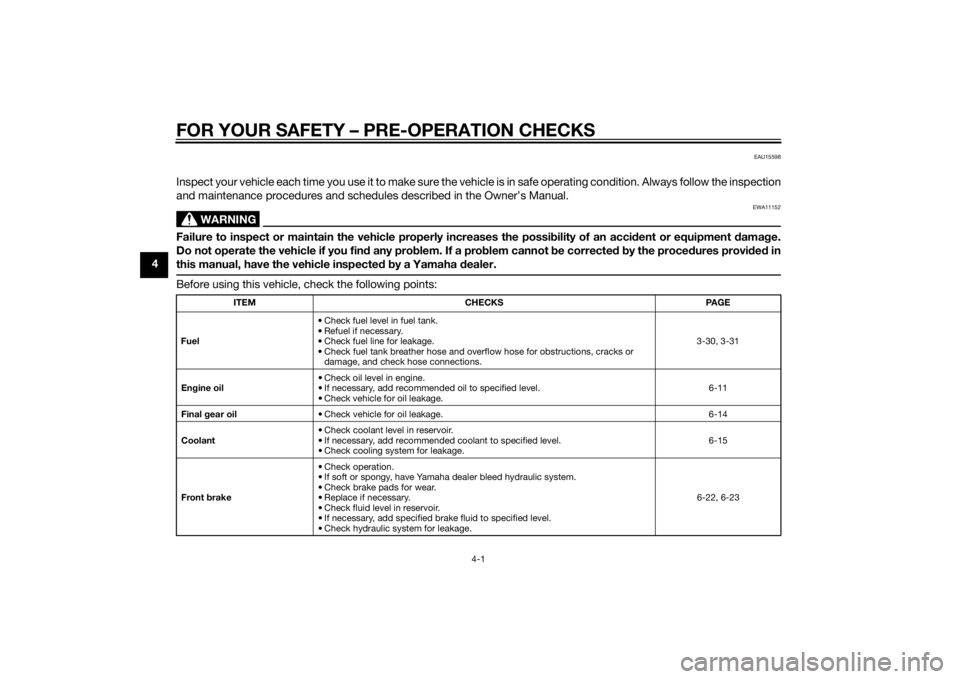
FOR YOUR SAFETY – PRE-OPERATION CHECKS
4-1
4
EAU15598
Inspect your vehicle each time you use it to make sure the vehicle is in safe operating condition. Always follow the inspection
and maintenance procedures and schedules described in the Owner’s Manual.
WARNING
EWA11152
Failure to inspect or maintain the vehicle properly increases the possibility of an acci dent or equipment damag e.
Do not operate the vehicle if you fin d any pro blem. If a pro blem cannot be corrected b y the proce dures provi ded in
this manual, have the vehicle inspecte d b y a Yamaha dealer.Before using this vehicle, check the following points:
ITEM CHECKS PAGE
Fuel • Check fuel level in fuel tank.
• Refuel if necessary.
• Check fuel line for leakage.
• Check fuel tank breather hose and overflow hose for obstructions, cracks or
damage, and check hose connections. 3-30, 3-31
En gine oil • Check oil level in engine.
• If necessary, add recommended oil to specified level.
• Check vehicle for oil leakage. 6-11
Final gear oil • Check vehicle for oil leakage. 6-14
Coolant • Check coolant level in reservoir.
• If necessary, add recommended coolant to specified level.
• Check cooling system for leakage. 6-15
Front brake • Check operation.
• If soft or spongy, have Yamaha dealer bleed hydraulic system.
• Check brake pads for wear.
• Replace if necessary.
• Check fluid level in reservoir.
• If necessary, add specified brake fluid to specified level.
• Check hydraulic system for leakage. 6-22, 6-23
U2BSE0E0.book Page 1 Tuesday, September 17, 2013 8:55 AM
Page 59 of 116

FOR YOUR SAFETY – PRE-OPERATION CHECKS
4-2
4
Rear brake • Check operation.
• If soft or spongy, have Yamaha dealer bleed hydraulic system.
• Check brake pads for wear.
• Replace if necessary.
• Check fluid level in reservoir.
• If necessary, add specified brake fluid to specified level.
• Check hydraulic system for leakage. 6-22, 6-23
Clutch • Check operation.
• If soft or spongy, have Yamaha dealer bleed hydraulic system.
• Check hydraulic system for leakage. 6-21
Throttle grip • Make sure that operation is smooth.
• Check throttle grip free play.
• If necessary, have Yamaha dealer adjust throttle grip free play and lubricate ca-
ble and grip housing. 6-17, 6-25
Wheels an d tires • Check for damage.
• Check tire condition and tread depth.
• Check air pressure.
• Correct if necessary. 6-18, 6-21
Brake an d shift pe dals • Make sure that operation is smooth.
• Lubricate pedal pivoting points if necessary.
6-25
Brake an d clutch levers • Make sure that operation is smooth.
• Lubricate lever pivoting points if necessary.
6-26
Si destan d • Make sure that operation is smooth.
• Lubricate pivot if necessary. 6-26
Chassis fasteners • Make sure that all nuts, bolts and screws are properly tightened.
• Tighten if necessary.
—
Instruments, li ghts, si gnals
an d switches • Check operation.
• Correct if necessary.
—
Si destan d switch • Check operation of ignition circuit cut-off system.
• If system is not working correctly, have Yamaha dealer check vehicle. 3-40
ITEM CHECKS PAGE
U2BSE0E0.book Page 2 Tuesday, September 17, 2013 8:55 AM
Page 60 of 116

OPERATION AND IMPORTANT RIDING POINTS
5-1
5
EAU15952
Read the Owner’s Manual carefully to
become familiar with all controls. If
there is a control or function you do not
understand, ask your Yamaha dealer.
WARNING
EWA10272
Failure to familiarize yourself with
the controls can lead to loss of con-
trol, which coul d cause an acci dent
or injury.
EAU48711
TIPThis model is equipped with: a lean angle sensor to stop the en-
gine in case of a turnover. In this
case, the multi-function display in-
dicates error code 30, but this is
not a malfunction. Turn the key to
“OFF” and then to “ON” to clear
the error code. Failing to do so will
prevent the engine from starting
even though the engine will crank
when pushing the start switch.
an engine auto-stop system. The
engine stops automatically if left
idling for 20 minutes. If the engine
stops, simply push the start
switch to restart the engine.
EAU54171
Startin g the en gineIn order for the ignition circuit cut-off
system to enable starting, one of the
following conditions must be met:
The transmission is in the neutral
position.
The transmission is in gear with
the clutch lever pulled and the
sidestand up.
See page 3-40 for more informa-
tion.
1. Turn the key to “ON” and make sure that the start/engine stop
switch is set to “ ”.
The following warning lights and
indicator lights should come on for
a few seconds, then go off. Oil level warning light
Engine trouble warning light
Traction control system indi-
cator/warning light
Cruise control indicator lights
Immobilizer system indicator
light
U2BSE0E0.book Page 1 Tuesday, September 17, 2013 8:55 AM